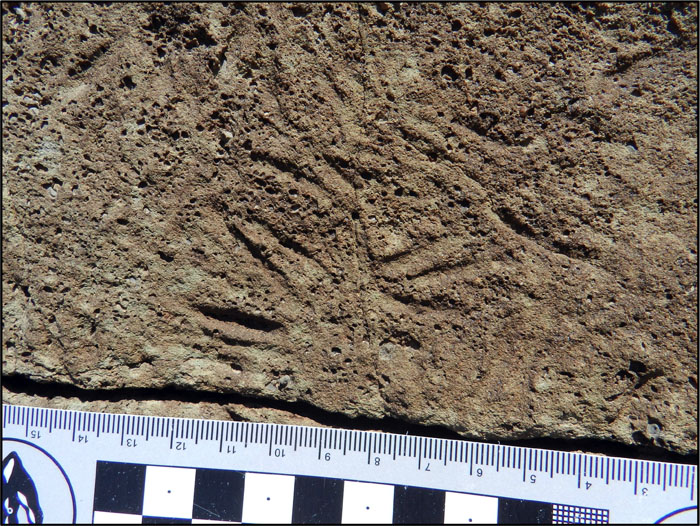After an undramatic (but still tiring) trip from Atlanta, Georgia to Berlin, Germany, I’m happy to be attending the Society of Vertebrate Paleontology annual meeting (SVP) in Berlin. The meeting – with talks, posters, and various social events – officially begins today (Wednesday, November 5) and continues through Saturday, November 9, but like all good paleontology meetings, it also has field trips before and afterwards.
Aside from my being with more than a thousand other paleontologists, exchanging information about the latest research, and enjoying good German beer while learning about this research (all of these are connected, I assure you), one of the main reasons why I am so far from Georgia is to present some of my research, too. It’s very much in the preliminary stages, but my coauthors and I thought it would be good to put this work out for other paleontologists to examine, poke, prod, and otherwise leave their impressions on it before we present it in a formal, peer-reviewed paper. I’ll be providing pictures and words expressing our work in a poster session today.
 Series of small grooves in an Early Cretaceous (about 100 million-year-old) sandstone in Arches National Park, Utah (USA). Notice how they make radiating patterns, too. Do you wonder what made these trace fossils? If so, join the club. My coauthors and I take a semi-educated guess, which is just below for your reading pleasure. (Photograph by Anthony Martin, taken in June 2012; scale in centimeters.)
Series of small grooves in an Early Cretaceous (about 100 million-year-old) sandstone in Arches National Park, Utah (USA). Notice how they make radiating patterns, too. Do you wonder what made these trace fossils? If so, join the club. My coauthors and I take a semi-educated guess, which is just below for your reading pleasure. (Photograph by Anthony Martin, taken in June 2012; scale in centimeters.)
The following abstract summarizes the work, but the preceding picture might help, as does this one-sentence summary at the start of the poster:
Linear grooves in Early Cretaceous sandstone beds of the Early Cretaceous (Aptian-Albian) Cedar Mountain Formation are likely feeding trace fossils made by a beaked vertebrate, such as a pterosaur or bird.
VERTEBRATE FEEDING TRACE FOSSILS IN THE CEDAR MOUNTAIN FORMATION (LOWER CRETACEOUS), ARCHES NATIONAL PARK, UTA (USA): BIRD, PTEROSAUR, OR UNKNOWN TRACEMAKER?
MARTIN, Anthony J., Emory University, Atlanta, GA, USA, 30322; KIRKLAND, James I., Utah Geological Survey, Salt Lake City, UT, USA; MILNER, Andrew R.C., St George Dinosaur Discovery Site at Johnson Farm, St. George, UT, USA; SANTUCCI, Vincent L., National Park Service, Washington, DC, USA.
ABSTRACT
Abundant linear grooves on sandstone bedding planes of the Ruby Ranch Member of the Cedar Mountain Formation (Lower Cretaceous) in Arches National Park (Utah, USA) are interpreted as feeding traces made by a beaked vertebrate, such as a bird or pterosaur. These grooves have regular lengths (15.7 ± 2.0 mm), widths (3.4 ± 0.3 mm), and depths (1.5 ± 0.7 mm; n = 30), indicating a common origin related to the behavior and anatomy of their tracemakers. The trace fossils are either: solitary, bundled together as parallel groups of 4-8 grooves, or form semi-circular to circular patterns of 35-70. Bundles forming arc-like patterns are 13-15 cm wide. Grooves are on the same surface with runzelmarken, invertebrate trails, tridactyl theropod tracks, and a didactyl dromaeosaurid track. Forms and patterns of these features do not correspond to any known inorganic structures or invertebrate traces, nor traces made by fish. Thus they are considered as trace fossils made by either birds or pterosaurs. Runzelmarken and laminations imply that algal films bound sedimentary surfaces and helped to preserve these trace fossils and their associated theropod tracks. Hence the grooves may have been grazing traces, in which tracemakers gouged just underneath and parallel to algal films by using hard body parts, such as beaks. If so, beaks would have been 3-4 mm wide and groove lengths would have been linked to beak length and neck movement. The diameter of the semicircular and circular patterns suggests that the tracemakers were relatively small vertebrates. Arc-like patterns of clustered grooves could have been made by the tracemaker standing in one spot or shifting laterally to systematically mine the surface. However, no pes tracks were observed in direct association with these grooves. Hence the traces also may have been formed.
Many thanks to my coauthors – Jim Kirkland, Andrew Milner, and Vincent Santucci – for their help on this research, which hopefully will get a little bit of the attention it deserves here in Berlin. Stay tuned this week for more ichnologically related posts, which I’ll try to write and publish in between all of the aforementioned enjoyable exchanges and German beer.
